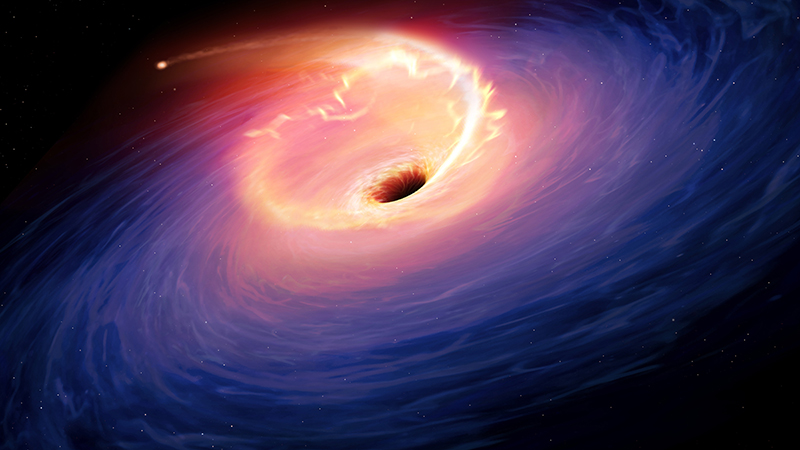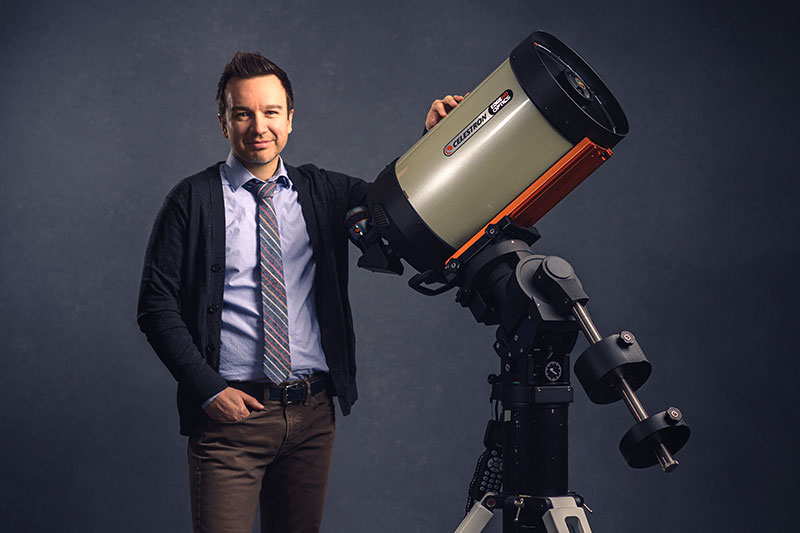
"Scary Barbie" is the affectionate nickname astronomers are calling one of the most energetic and luminous transients ever observed: a supermassive black hole tearing apart a massive star, as in this illustration. (Mark Garlick/Science Photo Library via Getty Images)
WEST LAFAYETTE, Ind. – A distant star, dying a fiery and dramatic death, torn apart by a supermassive black hole in a forgotten corner of the sky. One of the most luminous, energetic, long-lasting transient objects didn't blaze through the night sky inspiring legends and launching civilizations. Instead, astronomers, acting as celestial supersleuths, uncovered evidence of the star's death throes where it had hidden undetected for years in a mass of computer-gathered telescope data.
"It's absurd. If you take a typical supernova and multiply it a thousand times, we're still not at how bright this is – and supernovas are among the most luminous objects in the sky," said Danny Milisavljevic, an assistant professor of physics and astronomy in Purdue University's College of Science. "This is the most energetic phenomenon I have ever encountered."
In astronomy, things that are the most luminous are often the most energetic. Milisavljevic, an expert on stellar life cycles – especially star death – noted that the data points to an extremely anomalous observation.
The object, like all those observed, was assigned a random name when it was discovered. Its name is ZTF20abrbeie, or, as astronomers affectionately call it, "Scary Barbie." Barbie for its alphanumeric designation and "scary" because, Milisavljevic said, "It's so much of an outlier; its characteristics are terrifying!"
 Danny Milisavljevic, an expert on star life cycles, worked with a team of researchers and an AI program to uncover and identify one of the most luminous, energetic events ever observed in the universe.
Danny Milisavljevic, an expert on star life cycles, worked with a team of researchers and an AI program to uncover and identify one of the most luminous, energetic events ever observed in the universe. The object is what is known as a transient – something observed in the sky that either appears and then disappears or changes in some dramatic way over the course of hours or days rather than centuries or millennia. In a new paper accepted for publication in The Astrophysical Journal Letters, Milisavljevic, his graduate student Bhagya Subrayan, and their team analyzed the data to conclude that the bright, long-lived transient is a black hole in the process of consuming a star. Subrayan's research focuses on big data analysis of sky survey data.
"We think a very supermassive black hole pulled in a star and ripped it apart," Subrayan said. "The forces around a black hole, called tidal disruption, pull other objects apart in a process called 'spaghettification.' We think that's what happened, but on extreme time scales: The most massive of black holes ripping apart a massive star. The duration is unlike anything we've ever seen before, and it produced the most luminous transient in the universe."
If Scary Barbie is so bright and so notable, how did it just now come to light, even though datasets indicate the first observations occurred in 2020?
It hid in plain sight. While it's bright, it is also extremely far away and in a somewhat neglected corner of the sky. The anomaly was discovered using Milisavljevic's lab's AI engine. The Recommender Engine For Intelligent Transient Tracking (REFITT) combs through observations from a number of telescopes around the world, including those made by the Zwicky Transient Facility using the Palomar Observatory in California.
"REFITT does big data analysis," Milisavljevic said. "It combs through millions of alerts and figures out what interesting things we might want to look at closer. This is a great example. Computers are really good at finding things when we can tell them precisely what to look for. But things like this, anomalous objects, the computer often doesn't even know to look for. It doesn't even have a template. This is so different from anything else we've ever seen that we hadn't even gotten around to trying to classify it. It's been hanging out in the public data for years."
Once the team and REFITT had identified Scary Barbie as an intriguing opportunity for research, they used data from other telescopes, including the Lick Observatory in California and the W.M. Keck Observatory in Hawaii. Spectrographic analysis from those telescopes helped the team put a name to the odd phenomenon the data reported.
Scary Barbie is not just orders of magnitude brighter and more energetic than any transient scientists have recorded before, but it is also lasting much longer than usual transients do. Most transients last weeks or months, but this one has lasted for more than 800 days – over two years – and latest available data show that it may be visible for years to come.
The actual event itself – the spaghettification of this massive star – may be of much shorter duration, but because the transient is so far away the law of relativity slows down the light as it travels to human eyes, making it seem to last nearly twice as long.
"There are few things in the universe that can be so powerful, reactions that can be this long-lived," Milisavljevic said. "Discoveries like this really open our eyes to the fact that we are still uncovering mysteries and exploring wonders in the universe – things no one has ever seen before."
This research was funded in part by the National Science Foundation.






